Japan, a country steeped in rich culture, breathtaking landscapes, and delicious cuisine, awaits! But navigating a new country can be daunting, especially when faced with a different language. Fear not, intrepid traveler! With a few essential Japanese phrases under your belt, you’ll be ready to confidently greet locals, ask for directions, and savor the wonders Japan has to offer. Let’s dive into some key expressions that will make your first trip to Japan unforgettable.
While this list offers a comprehensive range of Japanese phrases, you won’t necessarily need to master them all, especially in major cities like Tokyo. Here’s what to focus on:
- Essential Communication: These core phrases will be your bread and butter, allowing you to greet people, ask for help, and express gratitude.
- Navigational Know-How: Getting around is key! Mastering basic directions (left, right, etc.) will be incredibly helpful when following instructions or asking for help.
- Numbers Basics: Knowing numbers 1-10 will come in handy for various situations, from understanding train platforms to deciphering price tags.
Don’t be intimidated by the full list – we’ll prioritize the most practical phrases to get you comfortable and confident during your Japanese adventure!
IMPORTANT NOTES
This handy phrase list is categorized for easy reference, covering greetings, common words, travel essentials, shopping, and dining.
Here are some pronunciation pointers to keep in mind:
Romanized Pronunciation: Japanese is generally pronounced as it’s written in Romanized form. Each syllable gets a clear sound, like “sa-ke” for sake.
Silent “U”: The “u” at the end of syllables is often silent. So, “desu” and “masu” sound more like “dess” and “mass.” For example, “onegaishimasu” becomes “onegaishi-mass.”
Variable “O”: Depending on the source, you might see “o” written as “ou,” “o,” or “ō.” Think of “doumo” (どうも) as an example.
Question Formation: Forming questions in Japanese is simple! Just add “ka” (か) to the end of a sentence. It acts like a question mark, like “Mō tabemashita ka?” (もう食べましたか?) which means “Have you eaten yet?”
By understanding these pointers, you’ll be well on your way to clear and confident communication in Japan!
JAPANESE GREETINGS WORDS
GOOD MORNING – OHAYOU GOZAIMASU (おはようございます)
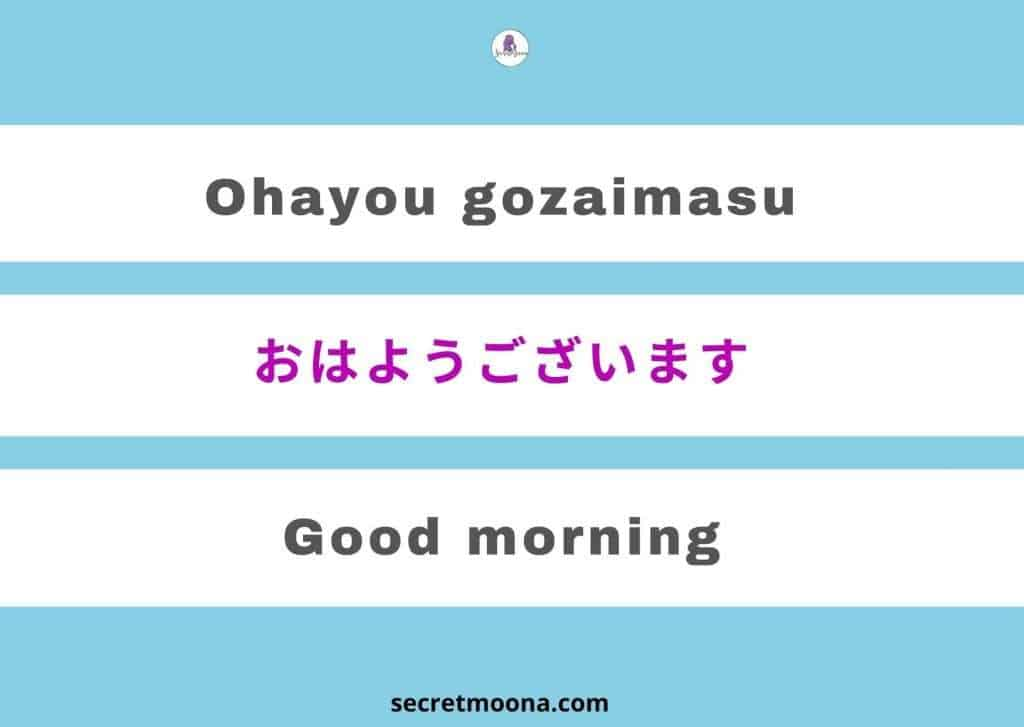
In Japanese culture, greetings play a crucial role in showing respect and acknowledging others. The language offers a range of greetings based on the time of day, the relationship between people, and the context of the interaction. For example, to say “Good morning,” you would use “Ohayou gozaimasu” (おはようございます).
If you’re looking to learn Japanese greetings, starting with “good morning” is a great choice. This greeting is commonly used before 10:00 am and varies in formality depending on the context and your relationship with the person you’re speaking to. Mastering and using the right Japanese greetings can help you show respect and foster positive interactions with those around you.
HELLO / GOOD AFTERNOON – KONNICHIWA (こんにちは)
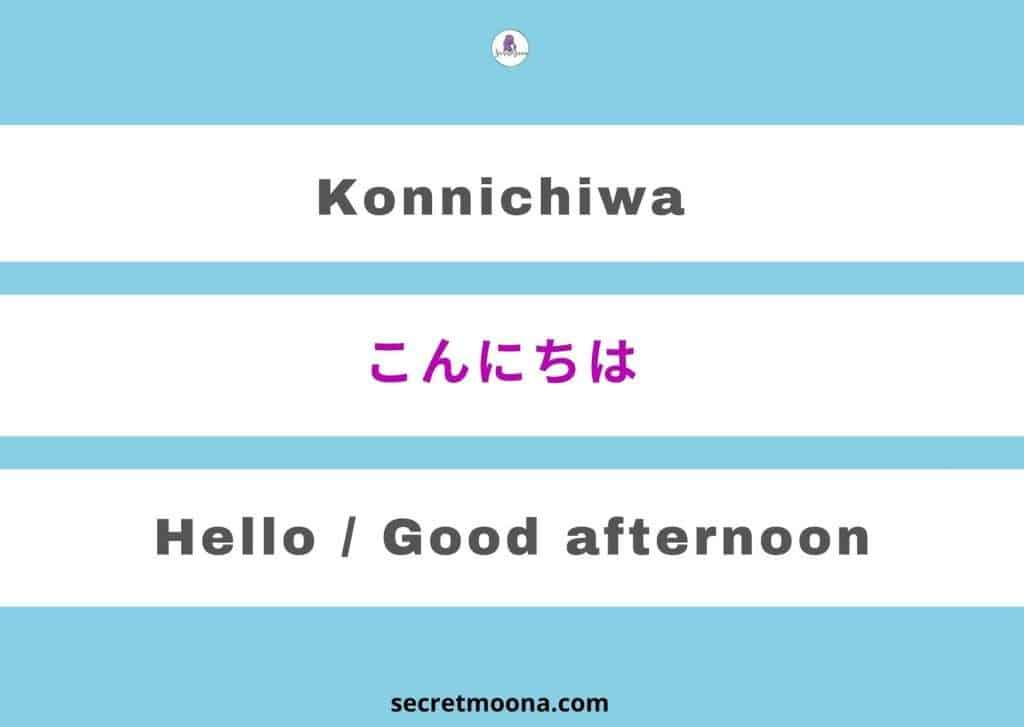
One common word you’ll hear in Japan is “Konnichiwa.” While it’s often written as “Konnichiwa” to help with pronunciation, the correct spelling is actually “Konnichiha.” This greeting, “Konnichiwa” (こんにちは), is used throughout the day to say “hi” or “hello,” though it literally means “good afternoon.”
GOOD EVENING – KONBANWA (こんばんは)

For greeting someone in the evening in Japanese, you use “Konbanwa.” This phrase is appropriate after sunset. Like “Konnichiwa,” the correct spelling is “Konbanha,” though it’s commonly written as “Konbanwa” for ease of pronunciation.
GOOD BYE – SAYOUNARA (さようなら)

“Sayonara” is a Japanese term used to say goodbye when you’re unsure if you’ll see the person again. For example, you might use “sayonara” when bidding farewell to hotel staff as you check out.
USEFUL JAPANESE PHRASES FOR TRAVELLERS
THANK YOU – ARIGATOU GOZAIMASU (ありがとうございます)

In Japan, politeness is deeply valued, so you will frequently hear and use the word “arigatou gozaimasu” (ありがとう) or the more informal “arigatou” to express gratitude. It’s best to use the polite version when addressing people you’ve just met.
YOU ARE WELCOME – DOU ITASHIMASHITE (どういたしまして)
When someone thanks you for your help or a kind gesture, it’s polite to respond with “Dou itashimashite,” which means “you’re welcome” in English. You can also use “iie” as a simpler alternative.
THANKS – DOUMO (どうも)
“Doumo” is a versatile word in Japanese. While it can be translated as “very,” it is also used in greetings like “hello” and to express gratitude for small favors.
DO YOU SPEAK ENGLISH? EIGO WO HANASHIMASU KA? (えいごを はなしますか)

To ask if someone speaks English, you can say “Eigo wo hanasemasu ka.” However, it’s polite to avoid asking locals this question as your first approach.
HOW ARE YOU? – O GENKI DESU KA? (お元気ですか)
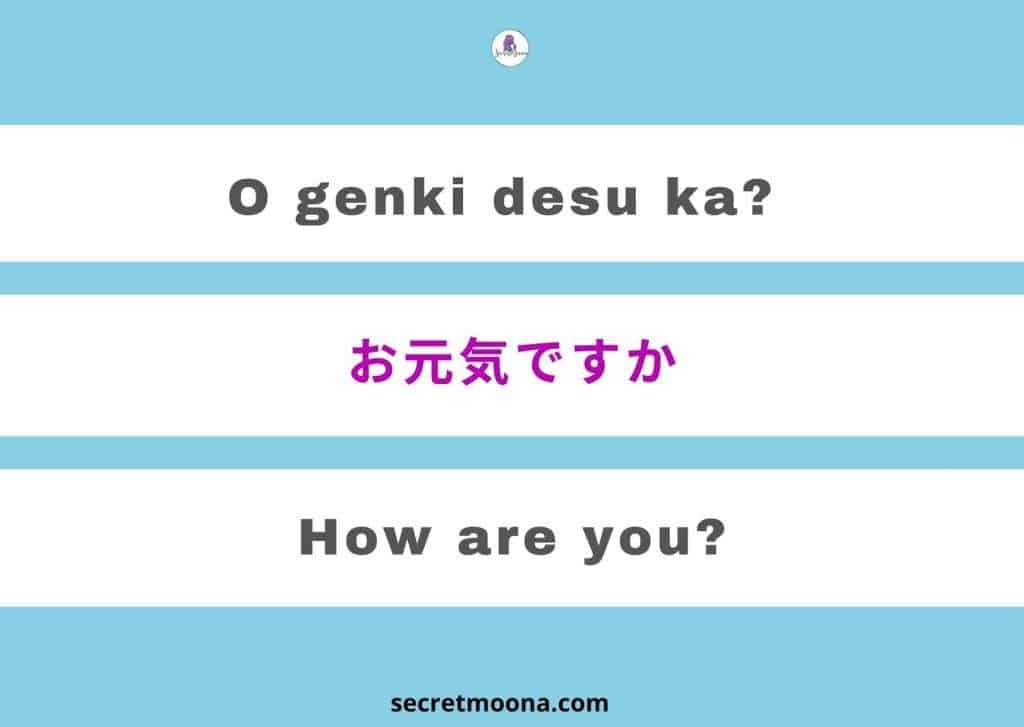
In Japan, instead of asking “How are you?” locals often say “How have you been?” To inquire about someone’s well-being, they use the phrase “お元気ですか” (Ogenki desu ka).
MAY I? – II DESU KA? (いいですか)
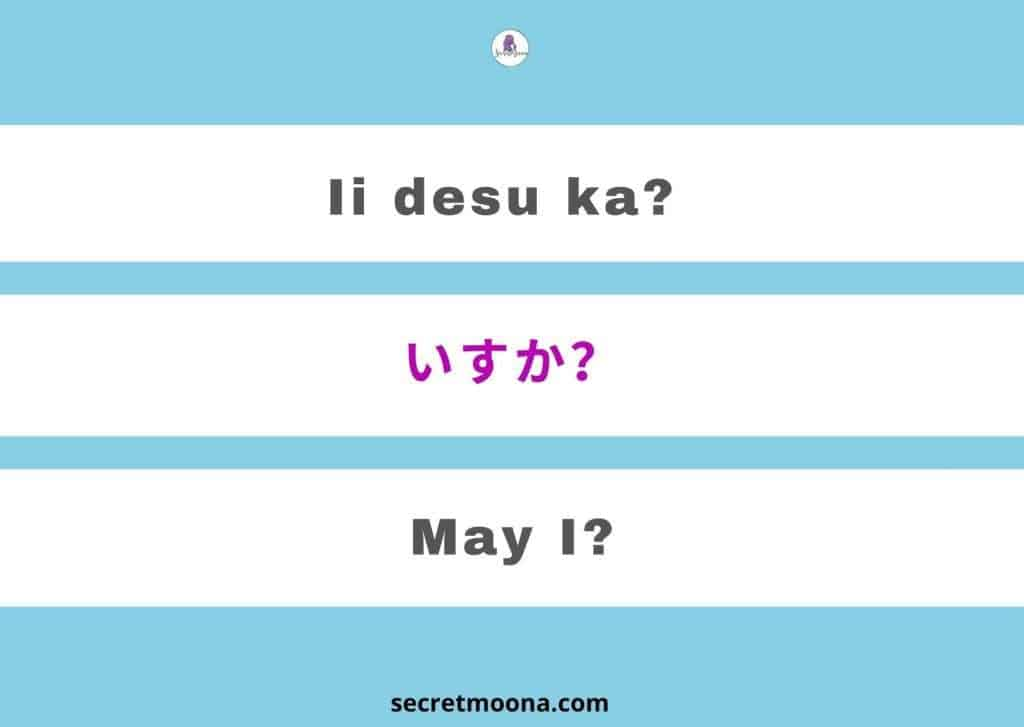
If you’re in Japan and want to photograph the local scenery, focus on capturing aspects of Japanese culture and traditions. However, be mindful of the rules and etiquette regarding photography. Some places may prohibit photography, and even where it’s allowed, it’s polite to ask for permission before taking pictures of people. You can use the phrase “Iidesu ka?” to request permission.
IS IT OKAY?/ARE YOU OKAY? – DAIJOUBU DESUKA? ( だいじょうぶですか)

When inquiring if something is okay, use “daijoubu desu ka?” You can also use this phrase to express concern for someone. To respond that you’re fine, say “daijoubu desu” (大丈夫です).
NO – IIE (いいえ)
The Japanese word for “no” is いいえ (iie), pronounced “ee-ye.” However, Japanese people often avoid saying “no” directly, as it can be considered impolite. Instead, it’s more common to use phrases like “daijoubu” (meaning “it’s okay”) or “kekkou desu” (meaning “I’m fine”). Another way to express disagreement is “chotto” (ちょっと), which means “a little” or “a bit.”
YES – HAI (はい)
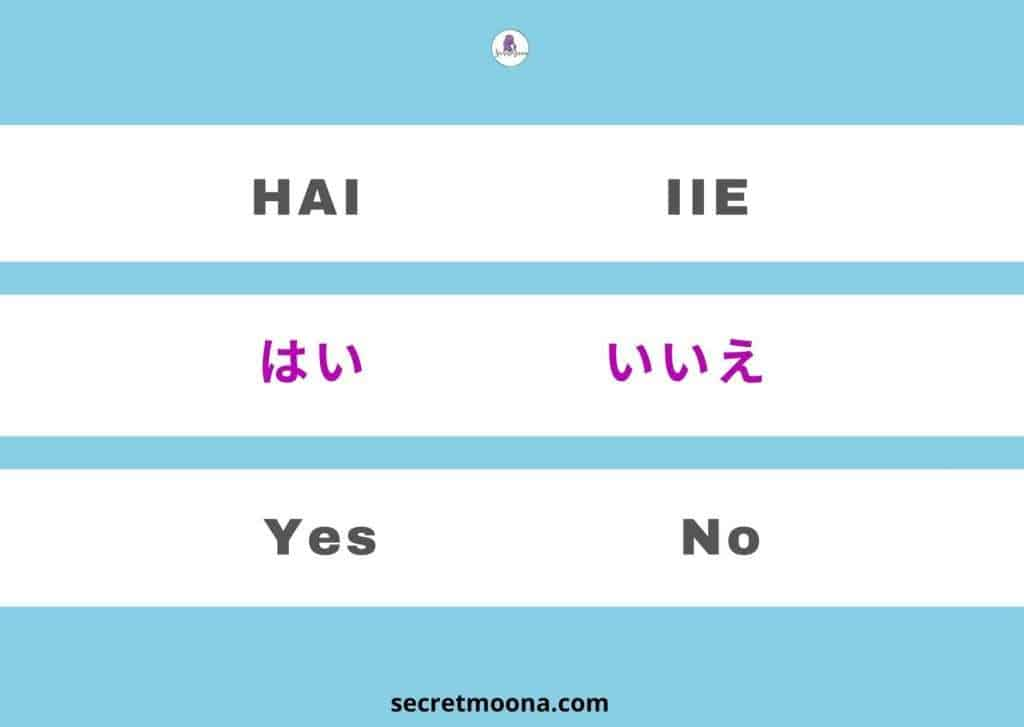
“Hai” and “un” both mean “yes” in Japanese, but “hai” can also be used to indicate “I understand.”
I DON’T UNDERSTAND – WAKARIMASEN (わかりません)
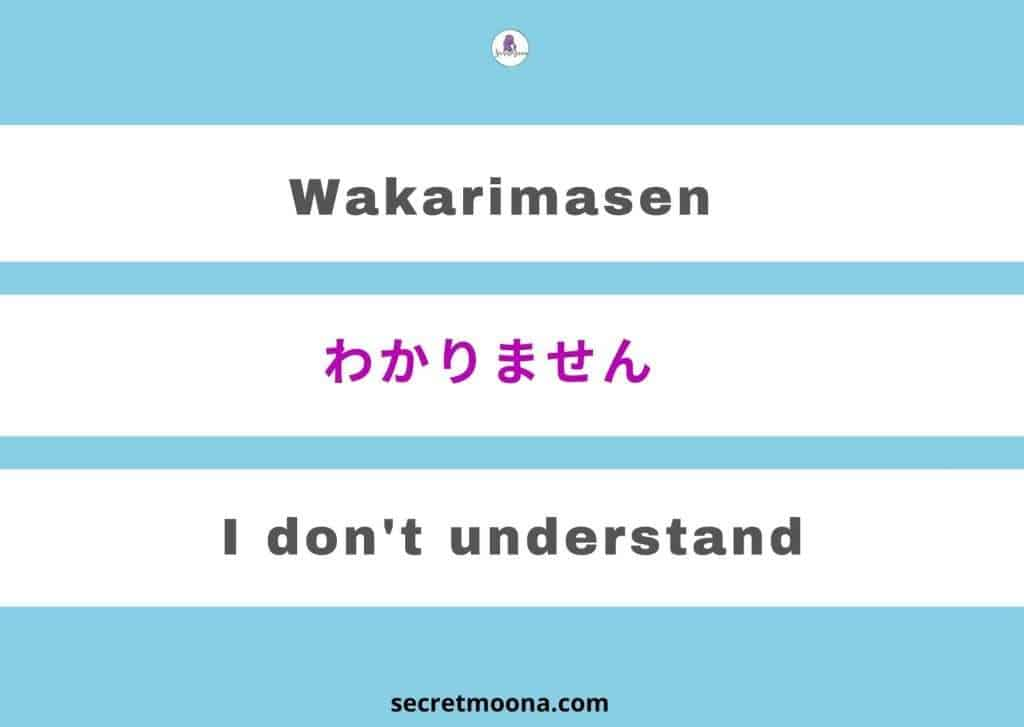
If you don’t understand what someone is saying, you can use the phrase “日本語がわかりません” (nihongo ga wakarimasen) to say “I don’t understand Japanese,” or simply say “ごめんなさい。わかりません。” (Gomen nasai. Wakarimasen) to express “Sorry, I don’t understand.”
PLEASE – KUDASAI (ください)

When asking someone to do something, it’s polite to use “kudasai (ください)” or the more formal “onegai shimasu (お願いします).”
SORRY – GOMEN NASAI (ごめんなさい)

If you accidentally bump into someone or hit their foot with your suitcase, it’s appropriate to apologize by saying “gomen nasai” while bowing.
SORRY/EXCUSE ME – SUMIMASEN (すみません)
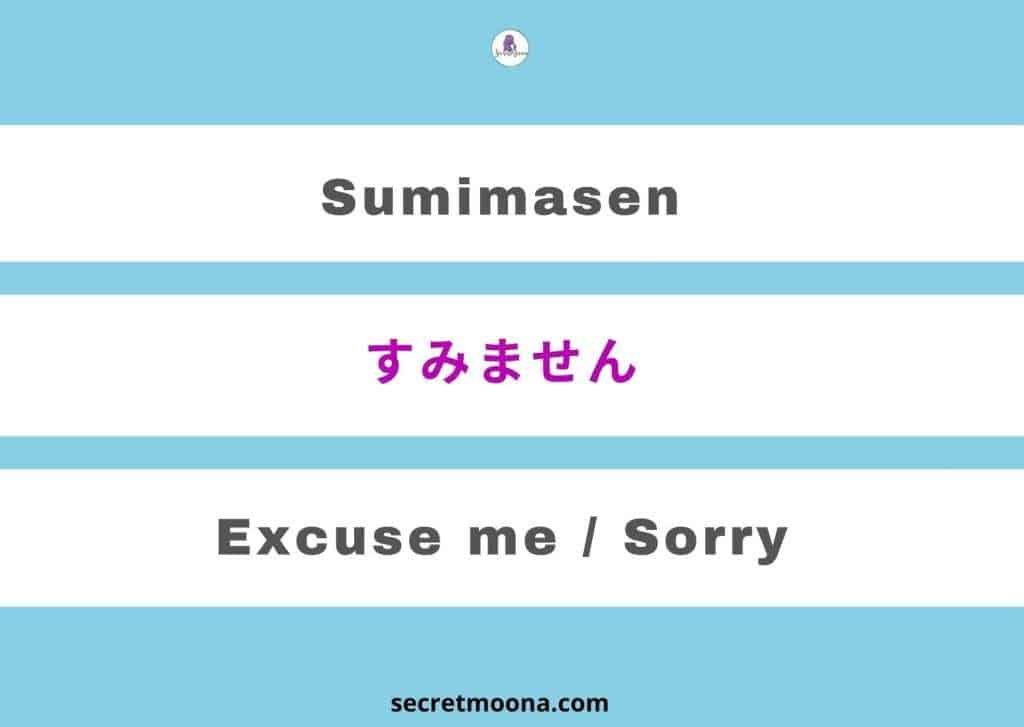
“Sumimasen” is a versatile word useful in many situations. It can be used to get someone’s attention, express gratitude, apologize (for any minor mishaps), or navigate through a crowd.
USEFUL PHRASES FOR TRAVELLING/GETTING AROUND
DOES THIS TRAIN/BUS GO TO ~ – KONO DENSHA/BUS WA ~ NI IKIMASUKA? (この電車/バスは~に行きますか)

While traveling in Japan, you’ll probably need to use public transportation and may want to confirm that you’re heading in the right direction. To check if you’re getting on the correct train or bus, you can ask, “Kore wa ~ ni ikimasu ka?” (これは~に行きますか?), which means “Does this go to ~?”
PLEASE, CAN I HAVE A MAP – CHIZU WO KUDASAI (地図をください)
Maps are often available to tourists at various attractions, but you may need to request one.
PLEASE TAKE ME TO ~ – ~ MADE ONEGAI SHIMASU ( ~までおねがいします)
When asking a taxi driver to take you to a specific location, you can use the phrase: “Onegai shimasu, Asakusa made” (お願いします、浅草まで).
I WANT TO GO TO ~ – ~ NI IKITAI DESU (~HEいきたいです)

When you want to go somewhere, you can say “ikitai desu,” which means “I want to go.” If you have an address but don’t know the name of the place, you can use “koko” to mean “here.” For instance, “Watashi wa kuukou ni ikitai desu” translates to “I want to go to the airport.”
WHERE IS ~? ~ WA DOKO DESU KA? (~はどこですか)

As a tourist, it’s common to get lost. To ask for directions, you can use the phrase “doko desu ka?” along with your destination or by pointing to a location on a map. “Doko” means “where.” For example, “Tokyo eki doko desu ka?” (eki means “station”) will help you find Tokyo Station. Even if the person you ask doesn’t speak English, they can usually guide you in the right direction. Here are some useful words to use with this phrase:
- Convenience store – コンビニ (konbini)
- Hotel – ホテル (hoteru)
- Train station – えき (eki)
- Toilet – トイレ (toire)
- Museum – はくぶつかん (hakubutsukan)
- Shopping centre – しょうてんがい (shotengai)
- Community police box – こうばん (kōban)
- Park – こうえん (kōen)
- Tourist information centre – かんこうあんないじょ (kankou annaijo)
Tip: If you need help, look for a kōban or shout たすけて (tasukete), which means “help.”
SHOPPING AND RESTAURANT
I WOULD LIKE THIS – KORE WO ONEGAI SHIMASU (これを おねがいします)
When placing an order, you can use “Kore” to indicate the dish or item on the menu you want.
HOW MUCH IS THIS? – KORE KURA DESU KA? (これは いくらですか)
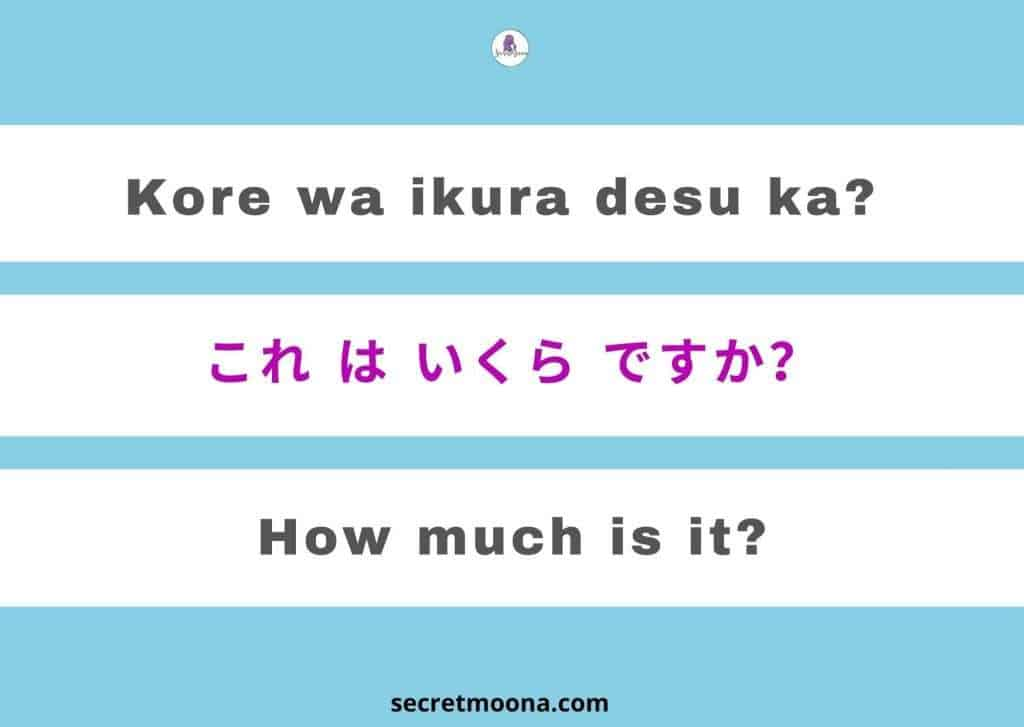
To ask about the price, say “Kore wa ikura desu ka?” where “ikura” means “how much.” Point to the item and use this phrase to inquire about its cost. To understand the answer, you’ll need to know how to count in Japanese. Fortunately, the seller will usually show you the price on a tag or use a calculator.
THE BILL / CHECK PLEASE? O KAIKEI WO ONEGAISHIMASU (お会計をおねがいします)

After finishing your meal, you can use this phrase to ask for the bill.
I CAN’T EAT – ~WA TABEMASEN (は食べられません)
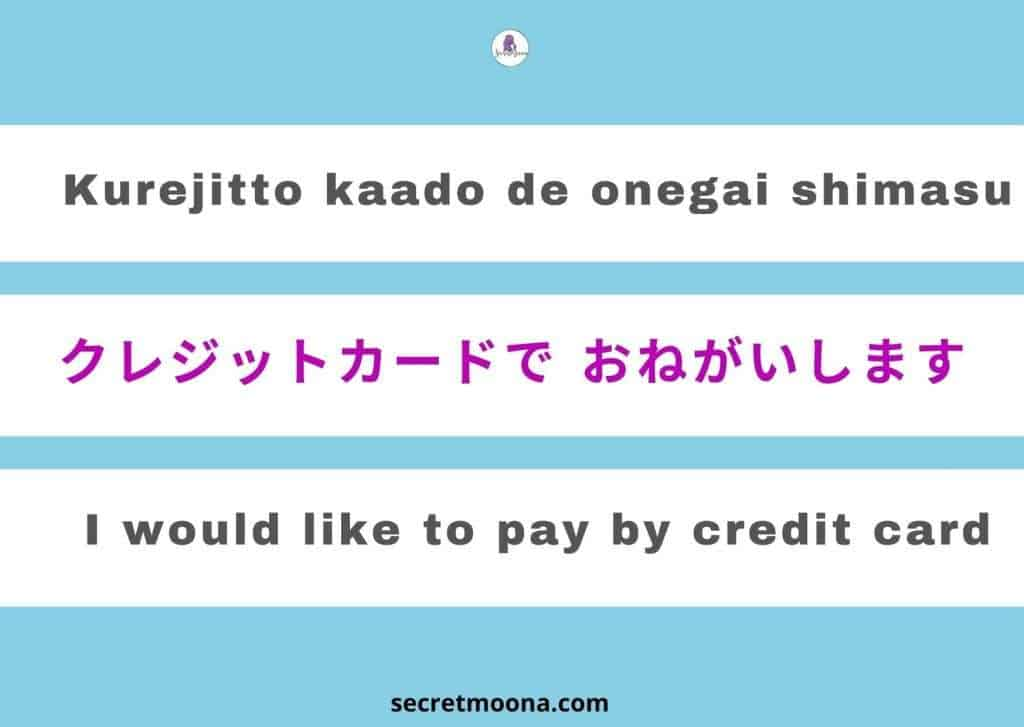
If you have a food intolerance, it’s important to know how to communicate it. For example, if you can’t eat gluten, you can say “Guruten wa taberaremasen” (グルテンは食べられません). Here is some useful vocabulary:
- Meat – niku (肉)
- Pork – botaniku (豚肉)
- Peanuts – pinattsu (ピーナッツ)
- Egg – tamago (卵)
- Fish – sakana (魚)
- Seafood – shiifūdo (シーフード)
- Dairy products – nyūseihin (乳製品)
If you want to pay by credit card, you can say “Kurejitto kaado de onegai shimasu” (クレジットカードでお願いします).
WHAT IS THIS? – KORE WA NAN DESU KA? (これは何ですか )
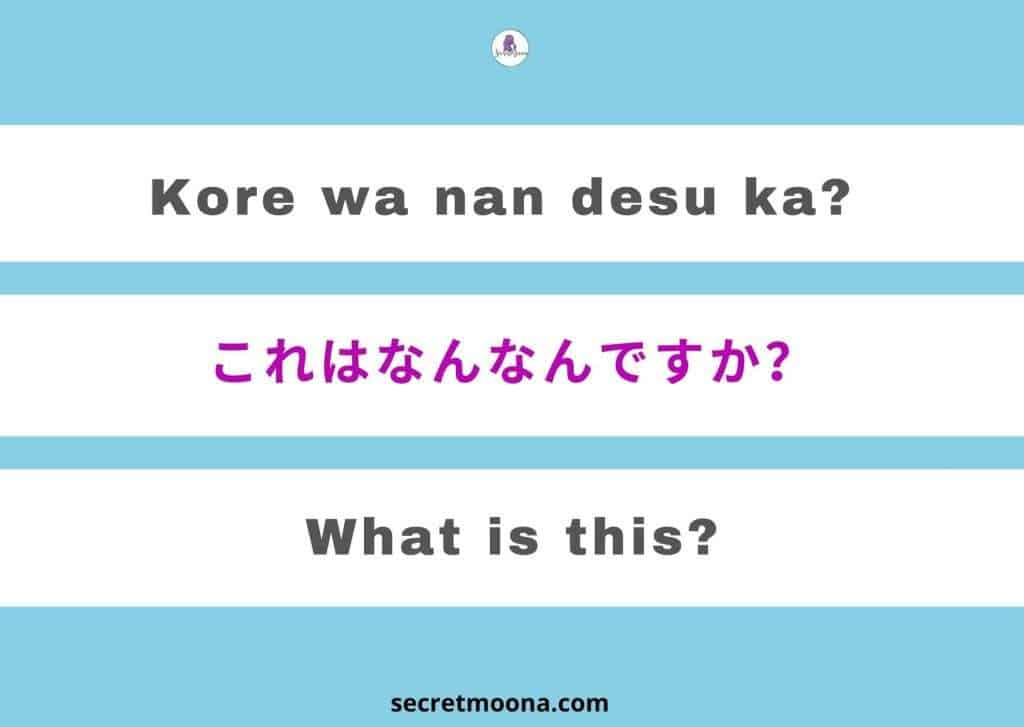
Japan is full of unique and unfamiliar things. If you encounter something you don’t recognize, this phrase will be useful.
LET’S EAT – ITADAKIMASU (いただきます)
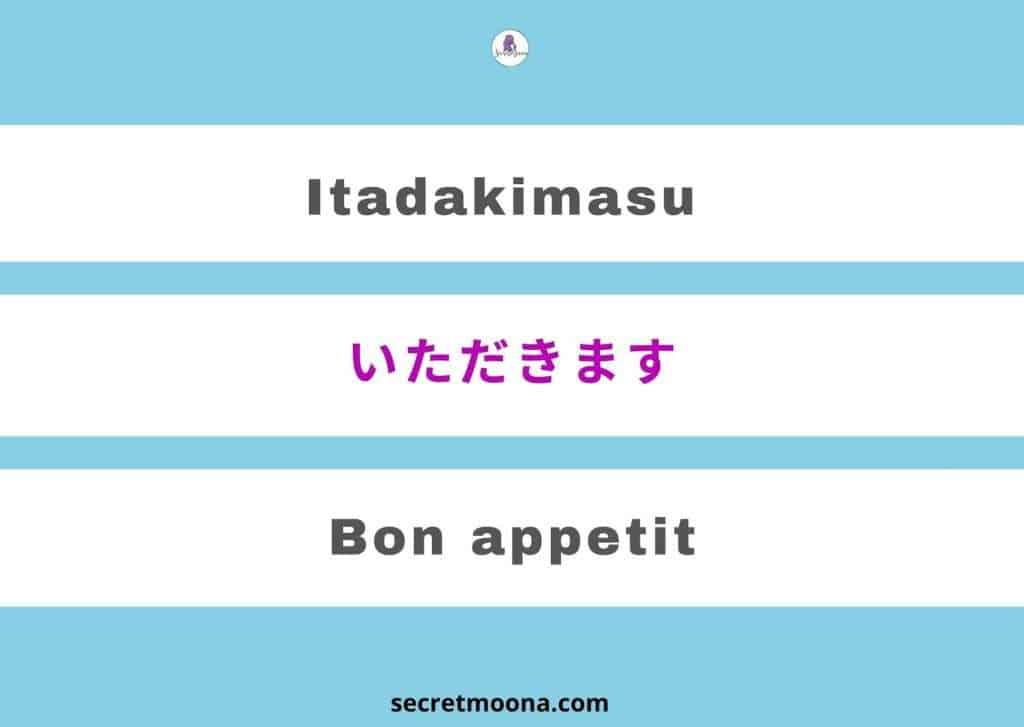
In Japan, it is customary to say “itadakimasu” before starting a meal, similar to the French “Bon appétit!” This tradition often includes clapping your hands together. After finishing your meal, especially in a restaurant where dishes are returned, you say “gochisousama deshita” to express your gratitude.
PLEASE, CAN I HAVE THE MENU? – MENYU WO ONEGAI SHIMASU – メニューを おねがいします
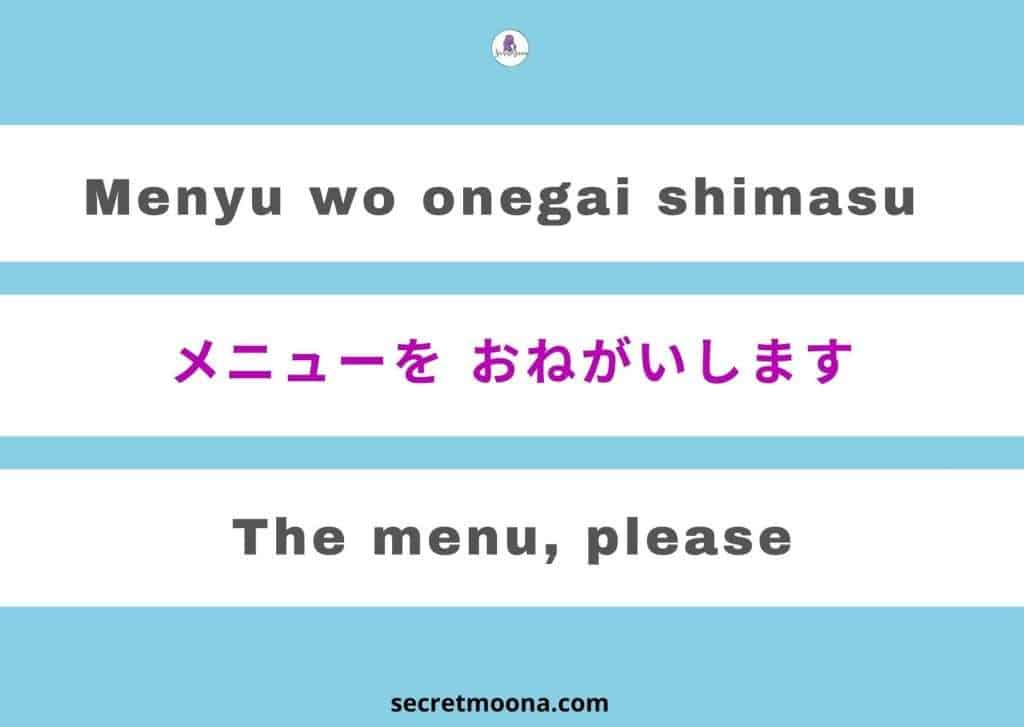
In restaurants, waiters typically won’t approach you automatically. If you’re ready to place an order, look for a bell on the table to signal them. If there isn’t one, you can get their attention by saying “sumimasen.”
A BRIEF NOTE ON JAPANESE CHARACTERS AND PRONUNCIATION

Japanese is a phonetic language, so if you pronounce words as you read them, you should be able to communicate well. Listening to spoken Japanese can help you get used to the pronunciation. Here’s a simple guide to Japanese pronunciation.
Japanese uses three types of scripts: Hiragana (ひらがな – with rounded shapes), Katakana (カタカナ – with sharp shapes), and Kanji (漢字 – based on Chinese characters). Hiragana and Katakana are simpler and phonetic, with each script having 46 characters that represent one syllable each. Kanji is more complex and consists of characters borrowed from Chinese.
Hiragana and Katakana cover the same sounds, but Katakana is often used for foreign words. Kanji is the most difficult to learn and requires more time because it comes from Chinese characters.
JAPANESE FOR TRAVELERS – ADDITIONAL LANGUAGE LEARNING RESOURCES
If you want to improve your Japanese language skills, there are several resources available, some of which are free. Here are a few tools that can help you:
- YouTube, Japanese Dramas, and TV Shows: Great for getting used to Japanese pronunciation and everyday language.
- JapanesePod101: Offers a wide range of audio lessons from beginner to advanced levels.
- Tae Kim’s Japanese Grammar Guide: A comprehensive guide to Japanese grammar.
- Japanese Language Books on Amazon: You can find many textbooks and study guides for different learning levels.
- NHK World Japanese Lessons: Provides useful phrases for daily use, travel, and more from the Japanese public broadcaster.
- Japanese-Lesson.com: A handy site for quick grammar and vocabulary checks.
- Tofugu: A valuable resource for learning Japanese.
- Japan Foundation: Offers an excellent, free online platform with tools for grammar, listening, and more.
CONCLUSION
Equipped with this essential phrase list and a few pronunciation pointers, you’re all set to navigate Japan with confidence! Remember, a simple “Konnichiwa” (こんにちは) and a smile go a long way. Don’t be afraid to make mistakes – the Japanese appreciate your effort to communicate in their language. So have fun, embrace the adventure, and enjoy the unforgettable experiences that Japan has to offer!







